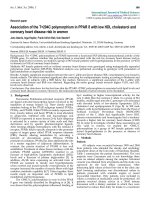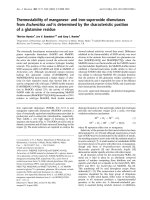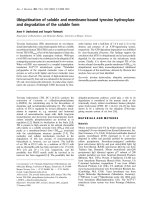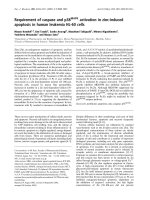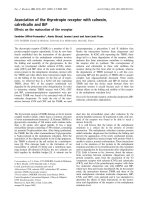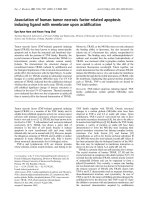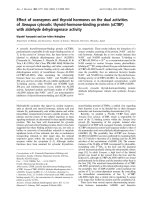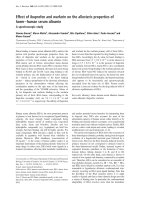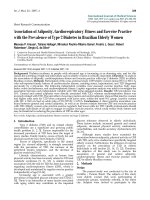Báo cáo y học: "Association of FCGR2A and FCGR2A-FCGR3A haplotypes with susceptibility to giant cell arteritis" pdf
Bạn đang xem bản rút gọn của tài liệu. Xem và tải ngay bản đầy đủ của tài liệu tại đây (149.99 KB, 6 trang )
Open Access
Available online />Page 1 of 6
(page number not for citation purposes)
Vol 8 No 4
Research article
Association of FCGR2A and FCGR2A-FCGR3A haplotypes with
susceptibility to giant cell arteritis
Ann W Morgan
1
, Jim I Robinson
1
, Jennifer H Barrett
1
, Javier Martin
2
, Amy Walker
1
,
Sarah J Babbage
1
, William ER Ollier
3
, Miguel A Gonzalez-Gay
4
and John D Isaacs
1,5
1
Leeds Institute for Molecular Medicine, University of Leeds, Leeds, UK
2
Instituto de Parasitología y Biomedicina López Neyra, CSIC, Granada, Spain
3
The Centre for Integrated Genomic Medical Research, The University of Manchester, Manchester, UK
4
Rheumatology Division, Hospital Xeral-Calde, Lugo, Spain
5
School of Clinical Medical Sciences (Rheumatology), University of Newcastle-Upon-Tyne, UK
Corresponding author: Ann W Morgan,
Received: 19 Dec 2005 Revisions requested: 19 Jan 2006 Revisions received: 19 Jun 2006 Accepted: 22 Jun 2006 Published: 17 Jul 2006
Arthritis Research & Therapy 2006, 8:R109 (doi:10.1186/ar1996)
This article is online at: />© 2006 Morgan et al.; licensee BioMed Central Ltd.
This is an open access article distributed under the terms of the Creative Commons Attribution License ( />),
which permits unrestricted use, distribution, and reproduction in any medium, provided the original work is properly cited.
Abstract
The Fc gamma receptors have been shown to play important
roles in the initiation and regulation of many immunological and
inflammatory processes and to amplify and refine the immune
response to an infection. We have investigated the hypothesis
that polymorphism within the FCGR genetic locus is associated
with giant cell arteritis (GCA). Biallelic polymorphisms in
FCGR2A, FCGR3A, FCGR3B and FCGR2B were examined
for association with biopsy-proven GCA (n = 85) and healthy
ethnically matched controls (n = 132) in a well-characterised
cohort from Lugo, Spain. Haplotype frequencies and linkage
disequilibrium (D') were estimated across the FCGR locus and
a model-free analysis performed to determine association with
GCA. There was a significant association between FCGR2A-
131RR homozygosity (odds ratio (OR) 2.10, 95% confidence
interval (CI) 1.12 to 3.77, P = 0.02, compared with all others)
and carriage of FCGR3A-158F (OR 3.09, 95% CI 1.10 to 8.64,
P = 0.03, compared with non-carriers) with susceptibility to
GCA. FCGR haplotypes were examined to refine the extent of
the association. The haplotype showing the strongest
association with GCA susceptibility was the FCGR2A-
FCGR3A 131R-158F haplotype (OR 2.84, P = 0.01 for
homozygotes compared with all others). There was evidence of
a multiplicative joint effect between homozygosity for FCGR2A-
131R and HLA-DRB1*04 positivity, consistent with both of
these two genetic factors contributing to the risk of disease. The
risk of GCA in HLA-DRB1*04 positive individuals homozygous
for the FCGR2A-131R allele is increased almost six-fold
compared with those with other FCGR2A genotypes who are
HLA-DRB1*04 negative. We have demonstrated that FCGR2A
may contribute to the 'susceptibility' of GCA in this Spanish
population. The increased association observed with a
FCGR2A-FCGR3A haplotype suggests the presence of
additional genetic polymorphisms in linkage disequilibrium with
this haplotype that may contribute to disease susceptibility.
These findings may ultimately provide new insights into disease
pathogenesis.
Introduction
Giant cell arteritis (GCA) is a common chronic granulomatous
vasculitis that is restricted to the over-50 population and thus
serves as a paradigm for ageing-related immunopathology.
Permanent ischaemic lesions, predominantly irreversible blind-
ness, occur in 15% of patients due to hyperplasia of the intimal
layer of involved arteries and non-thrombotic luminal occlu-
sion. Some patients present acutely with blindness, secondary
to anterior ischaemic optic neuropathy or central retinal artery
occlusion, whereas others present with a systemic inflamma-
tory syndrome [1]. High-dose steroids are conventionally used
to prevent these ischaemic complications, but in an elderly
population this leads to a high incidence of adverse events [2].
There is some evidence that GCA is an antigen-driven, autoim-
mune disease. One of the earliest changes within the vessel
wall is the accumulation of dendritic cells within the adventitia,
which are believed to initiate and maintain antigen-specific
adaptive immune responses, following an as yet unknown vas-
cular insult [3]. The familial clustering of GCA supports a
CI = confidence interval; FcγR = Fc gamma receptor; GCA = giant cell arteritis; NA = neutrophil antigen; OR = odds ratio.
Arthritis Research & Therapy Vol 8 No 4 Morgan et al.
Page 2 of 6
(page number not for citation purposes)
genetic component, and there is a strong association with
HLA-DRB1*04 in many different populations [4]. Within
cohorts of biopsy-proven GCA, HLA-DRB1*04 is associated
with systemic signs and symptoms [5], visual manifestations
[6] and corticosteroid resistance [7]. Many other studies have
examined genetic variants in key components of immune and
inflammatory pathways known to be activated in this disease.
Associations with polymorphisms in genes encoding tumour
necrosis factor [8], interleukin-4 [9], intracellular adhesion mol-
ecule-1 [10], vascular endothelial growth factor [11,12] and
endothelial nitric oxide synthase have been reported in some
cohorts [13,14], although many are awaiting replication in a
second population. Variant alleles of mannose-binding lectin,
which result in low levels of mannose-binding lectin protein,
are also associated with GCA, perhaps through modulation of
phagocytic function [15].
There is some epidemiological evidence, such as clustering of
cases in space and time, that infection may act as a trigger for
both GCA and polymyalgia rheumatica [16]. Organisms pro-
posed include parvovirus B19 and Chlamydia pneumoniae,
but the evidence remains inconclusive [17]. Infections may
lead to vasculitis through various mechanisms: for example,
interactions between microbial ligands and endogenous mol-
ecules, impairment of pathogen clearance, molecular mimicry,
modification of self epitopes into 'neo-antigens', or failure to
down-regulate the alloimmune response [18]. The ageing
process itself leads to a functional decline in adaptive and
innate immune responses, known as immunosenescence, in
association with an increased susceptibility to infections,
malignancies and autoimmune/inflammatory disorders.
Although GCA-specific autoantibodies have not been
described, antibodies against a broad range of human autoan-
tigens have been observed in both types of GCA [19]. Anticar-
diolipin antibodies have been reported, particularly in biopsy-
positive GCA [20], and often disappear with steroid treatment
[21]. Furthermore, the pathogenicity of anti-endothelial anti-
bodies, which have been demonstrated in up to 50% of GCA
patients, remains to be elucidated, but such antibodies have
the potential to mediate Fc gamma receptor (FcγR) cross-link-
ing and trigger downstream effector functions [22].
The FcγRs, which bind IgG containing immune complexes/IgG
autoantibodies, have been shown to play important roles in the
initiation and regulation of many immunological and inflamma-
tory processes and to amplify and refine the immune response
to an infection. Activating FcγRs (FcγRI, FcγRIIa, FcγRIIIa,
FcγRIIIb) potentiate phagocytosis in response to IgG-contain-
ing immune complexes/opsonised micro-organisms and trig-
ger the oxidative burst, degranulation, maturation and release
of cytokines, including tumour necrosis factor-α [23-25].
FcγR-mediated endocytosis by antigen presenting cells, such
as dendritic cells, results in efficient MHC class I and II pres-
entation [26]. FcγRIIIa cross-linking additionally stimulates
antigen-dependent cellular cytotoxicity by natural killer cells
and macrophages. Conversely, FcγRIIb contains an inhibitory
motif in the cytoplasmic tail that abrogates cellular activation
and down-regulates the antibody response, thus acting as a
negative feedback mechanism [23-25]. Polymorphic variants
that increase the expression or affinity of these IgG receptors,
or enhance their ability to bind specific IgG isotypes, may,
therefore, play an important role in determining both the inflam-
mation mediated by IgG (auto)antibodies and IgG-containing
immune complexes and/or the susceptibility to specific infec-
tions that may be associated with triggering vascular/inflam-
matory disease.
We have examined the hypothesis that the FCGR genetic
locus is associated with susceptibility to GCA in a previously
well-characterised GCA cohort from north-western Spain.
Materials and methods
Giant cell arteritis patients and controls
This was an allelic association study where FCGR2A,
FCGR3A, FCGR3B and FCGR2B alleles and pairwise haplo-
types were examined in a well-characterised GCA cohort from
Lugo, Spain [6,27]. Briefly, all patients and controls were of
local Spanish descent and originated from the area surround-
ing Lugo, Galicia, in north-western Spain. They comprised 217
individuals (132 healthy controls and 85 GCA patients). All
patients were recruited from Xeral-Calde Hospital (Lugo) and
all patients fulfilled the 1990 American College of Rheumatol-
ogy criteria for the classification of GCA and had a positive
temporal artery biopsy [28]. All controls were healthy volun-
teers, who could trace their ancestry in the region for at least
three generations. Ethical approval was obtained from the
respective Local Research Ethics Committees.
FCGR genotyping
Genotyping at the FCGR locus is complex in view of the high
level of structural homology between the three class II
(FCGR2A, FCGR2B and FCGR2C) and two class III
(FCGR3A and FCGR3B) receptors. Gene duplication at this
locus is believed to have occurred as a result of an unequal
crossover event [29] with subsequent divergence of biological
functions. The functional FCGR2A-131H/R, FCGR3A-158F/
V and FCGR3B-NA1/NA2 polymorphisms and 3' untranslated
region FCGR2B-1206G/A single nucleotide polymorphism
were genotyped using assays that have previously been vali-
dated in our laboratory [30,31]. FCGR2A genotyping was per-
formed by direct sequencing for >80% of samples. The FCGR
gene order from centromere to telomere at chromosome 1q23
is FCGR2A, FCGR3A, FCGR2C, FCGR3B, FCGR2B
[31,32].
Statistical analyses
Statistical analyses were performed using the Stata statistical
software (Stata Corporation 2005, Stata Statistical Software:
Release 9.0, College Station, Texas, USA) unless otherwise
stated. The power calculations for this study were based on
Available online />Page 3 of 6
(page number not for citation purposes)
the FCGR allele frequencies observed in the UK population
[31]. A cohort of 85 GCA cases and 130 controls provides
80% power to detect an odds ratio (OR) of 2.5 or 2.9 for a
dominant and recessive mode of inheritance, respectively,
assuming an allele frequency of 0.35 (5% significance level);
for an allele frequency of 0.5 the corresponding ORs are 3.2
and 2.5). Hardy-Weinberg equilibrium was investigated in
each control population using an exact test. Allele and geno-
type frequencies were compared using 2 × 2 and 3 × 2 con-
tingency tables, respectively. Two-sided P values below 0.05
were considered statistically significant throughout.
ORs and their 95% confidence intervals (CI) were calculated
to quantify the magnitude of all significant associations, as an
approximation of the relative risk. Haplotype frequencies were
estimated pairwise across the FCGR locus using the Estimat-
ing Haplotypes PLUS (EHPLUS) program [33], which also
calculates the empirical significance (P value) of overall link-
age disequilibrium. The standardised disequilibrium coeffi-
cient (D') was calculated for each pair of FCGRs, utilizing the
gene order derived from our electronic contig. The heteroge-
neity test within the Permutation and Model-free analysis pro-
gram was used to test for association with disease. A
permutation procedure implemented in this program enabled
1,000 permutations to be performed [33].
Association of FCGR haplotypes with GCA was investigated
further using the haplotype trend regression approach pro-
posed by Zaykin and colleagues [34] for dealing with uncer-
tain phase. In this method, logistic regression can be used to
relate disease status to an individual's haplotypes; where
these are not known with certainty all haplotypes consistent
with the genotypes are included as predictors, weighted by
their probabilities (based on the estimated haplotype frequen-
cies). This approach estimates the effect on risk of each hap-
lotype assuming the effect of the two haplotypes is
independent. Stepwise regression analyses were also used to
investigate a possible interaction with HLA-DRB1*04 [35].
Results
Association of FCGR2A, FCGR3A, FCGR3B and FCGR2B
with giant cell arteritis
There was no evidence of departure from Hardy-Weinberg
equilibrium in the control group for any genotyped polymor-
phism.
There was weak evidence of a difference in the distribution of
FCGR2A-131H/R alleles (P = 0.05) and genotypes (P =
0.06) between cases and controls (Table 1). The data sup-
ported a recessive model and individuals homozygous for the
FCGR2A-131R allele had an increased risk of GCA (OR 2.10,
95% CI 1.12 to 3.77, P = 0.02, compared with all others).
There was also a trend towards an increase in the FCGR3A-
158F/V allele (P = 0.06) and genotype (P = 0.08) frequencies
in GCA patients compared to controls (Table 1). The data
were consistent with a dominant model and carriage of the
FCGR3A-158F allele was associated with GCA (OR 3.09,
95% CI 1.10 to 8.64, P = 0.03). There were no significant dif-
ferences in FCGR3B or FCGR2B allele or genotype frequen-
cies between GCA subjects and controls.
Linkage disequilibrium at the FCGR genetic locus
Significant linkage disequilibrium was observed between
FCGR2A and FCGR3A (D' = 0.31, P = 0.01) and FCGR3A
and FCGR3B (D' = -0.64, P = 0.0001) in the control popula-
tion. The negative D' values indicate linkage disequilibrium
between the commonest allele of one gene and the least com-
mon allele of the second gene (Table 2).
Table 2
Pairwise linkage disequilibrium measures (D') calculated from
the control group
D' measures for the control population
FCGR2A FCGR3A FCGR3B
FCGR3A -0.31
FCGR3B -0.07 -0.64
FCGR2B -0.03 0.05 -0.37
Values of 0.3 and higher highlighted in bold.
Table 1
Genotype frequencies (number and proportion) in subjects
with giant cell arteritis compared to controls
Gene Genotype Control (n
= 132)
GCA (n =
85)
P value
FCGR2A-
131
RR 29 (0.23) 32 (0.39)
RH 63 (0.51) 33 (0.40) 0.06
HH 32 (0.26) 18 (0.22)
FCGR3A-
158
FF 47 (0.41) 40 (0.48)
FV 49 (0.43) 38 (0.46) 0.08
VV 19 (0.16) 5 (0.06)
FCGR3B-
NA
22 49 (0.45) 36 (0.44)
21 50 (0.46) 35 (0.43) 0.77
11 10 (0.09) 10 (0.12)
FCGR2B-
1206
GG 59 (0.49) 36 (0.44)
GA 47 (0.39) 34 (0.41) 0.77
AA 15 (0.12) 12 (0.15)
GCA, giant cell arteritis.
Arthritis Research & Therapy Vol 8 No 4 Morgan et al.
Page 4 of 6
(page number not for citation purposes)
Association of FCGR haplotypes with giant cell arteritis
The distributions of two-locus FCGR haplotypes were com-
pared between the GCA and control populations, with a differ-
ence approaching statistical significance for FCGR2A-
FCGR3A (Table 3). Compared with the control frequency of
36%, the FCGR2A-FCGR3A 131R-158F haplotype was
found at increased frequency in GCA patients (50%).
From the haplotype trend regression analysis of FCGR2A-
FCGR3A haplotypes, the 131R-158F haplotype was found to
have a significant effect on the risk of GCA (OR 1.72, 95% CI
1.02 to 2.89, P = 0.04), compared to the H-V haplotype as
baseline. These are maximum likelihood estimates of the effect
of each haplotype assuming a log-additive combined effect of
an individual's two haplotypes. Further analysis treating the
number of copies of this haplotype as a factor shows that the
effect of the haplotype is largely confined to those with two
copies (data not shown). FCGR2A-FCGR3A haplotypes
were analysed under a recessive model, where homozygosity
for this haplotype was observed in 12% healthy controls com-
pared with 27% GCA population giving an OR of 2.84, 95%
CI 1.33 to 6.06 (P = 0.01) when homozygotes were com-
pared with all others.
Contribution of FCGR2A genotype and HLA-DRB1*04
alleles in giant cell arteritis susceptibility
There was evidence of a multiplicative joint effect between
homozygosity for FCGR2A-131R and HLA-DRB1*04 positiv-
ity, consistent with both of these two genetic factors contrib-
uting to the risk of disease (OR 2.23, 95% CI 1.09 to 4.58 and
OR 2.61, 95% CI 1.30 to 5.22, respectively, from a model
including both predictors). Thus, the risk of GCA in HLA-
DRB1*04 positive individuals homozygous for the FCGR2A-
131R allele is increased almost six-fold compared with those
with other FCGR2A genotypes who are HLA-DRB1*04 neg-
ative. There is no evidence of an interaction between these
two genetic loci (P = 0.19 from a likelihood ratio test).
Discussion
We have demonstrated a significant association between
FCGR2A-131RR (OR 2.1, P = 0.02) and FCGR3A-158F
(OR 3.09, P = 0.03) with susceptibility to GCA. Haplotype
analyses can be more informative in their ability to identify dis-
ease predisposing genes. They may also provide additional
evidence for the presence of unidentified polymorphic variants
that are in linkage disequilibrium with the haplotype and are
the true disease-susceptibility variants [36]. Accordingly,
homozygosity for the FCGR2A-FCGR3A 131R-158F haplo-
type was associated with an almost three-fold increased risk
of GCA (OR 2.84, P = 0.01).
The FcγRs play important roles in the initiation and propaga-
tion of many different immunological and inflammatory proc-
esses. The two alloforms (FCGR2A-131R and FCGR3A-
158F) contained within the GCA-susceptibility haplotype
encode low affinity variants (FcγRIIa-131R and FcγRIIIa-158F).
FcγRIIa is the major phagocytic FcγR in humans and has two
co-dominantly expressed alleles, 131H and 131R. The 131H
isoform is the only FcγR that can bind IgG2, an antibody sub-
class that is also a poor activator of the classical complement
pathway. FCGR2A-131H is, therefore, essential for handling
IgG2 immune complexes: individuals homozygous for the
Table 3
Estimated pairwise haplotype frequencies in giant cell arteritis compared with healthy controls
Genes Haplotype Control GCA P value
FCGR2A-FCGR3A 131R-158F 0.360 0.502
131R-158V 0.135 0.078 0.07
131H-158F 0.246 0.208
131H-158V 0.259 0.212
FCGR3A-FCGR3B 158F-NA2 0.347 0.444
158F-NA1 0.272 0.268 0.16
158V-NA2 0.339 0.225
158V-NA1 0.042 0.063
FCGR3B-FCGR2B NA2-1206G 0.426 0.343
NA2-1206A 0.255 0.317 0.30
NA1-1206G 0.255 0.311
NA1-1206A 0.064 0.029
Pairwise haplotypes produced from four biallelic markers (FCGR2A-131H/R, FCGR3A-158F/V, FCGR3B-NA2/1 and FCGR2B-1206G/A)
denoted in the order they occur at the FCGR locus. Thus, 131R-158F indicates a haplotype containing FCGR2A-131R and FCGR3A-158F
alleles. Empirical P values were obtained from a heterogeneity test statistic incorporated in the Permutation and Model-free analysis program after
1,000 permutations.
Available online />Page 5 of 6
(page number not for citation purposes)
131R-allele have been shown to have an increased suscepti-
bility to various encapsulated bacterial infections, such as
Neisseria meningitides, Haemophilus influenzae and Strepto-
coccus pneumoniae [37-39]. FcγRIIIa is expressed on natural
killer cells, macrophages, γδ T-cells and a subset of mono-
cytes. Consequently, they may act as susceptibility factors for
GCA through a variety of mechanisms, such as an inability to
bind IgG2 haplotypes (FcγRIIa-131R) on a background of
impaired FcγR-mediated phagocytosis (FcγRIIa-131R and
FcγRIIIa-158F) and impaired antigen-dependent cellular cyto-
toxicity of IgG-opsonised cells (FcγRIIIa-158F). Alternatively,
FcγR polymorphisms may modulate endothelial leukocyte
ingress, dendritic cell endocytosis and antigen presentation
[26], or macrophage/natural killer cell effector functions to IgG
containing immune complexes, each of which could separately
influence the pathogenesis of GCA.
The same polymorphic variants have also been demonstrated
to be associated with susceptibility to a variety of autoimmune
diseases. For example, systemic lupus erythematosus is asso-
ciated with the same FCGRIIA-131R, FCGRIIIA-158F and
FCGRIIIB-NA2 alleles, whereas relapses in Wegener's gran-
ulomatosis are associated with FCGRIIA-131R and FCGRI-
IIA-158F alleles [40]. Flares in both systemic lupus
erythematosus and Wegener's may be triggered by infection,
particularly chronic nasal carriage of Staphylococcus aureus
in the latter, but the picture is also complicated by impaired
FcγR-mediated clearance of pathogenic autoantibodies and
immune complexes.
Conclusion
Genetic polymorphism within the FCGR genetic locus may
contribute to the development of GCA. The immunological
consequences of these subtle defects in the innate immune
system may be enhanced in the presence of immunosenes-
cence, and the increased susceptibility to infection may poten-
tially allow triggering of the inflammatory process in GCA.
Additional studies from other ethnic groups will be required to
confirm these genetic associations.
Competing interests
The authors declare that they have no competing interests.
Authors' contributions
AWM participated in the design of the study, oversaw all
aspects of the laboratory work, analysed the data and pre-
pared the manuscript. JIR, AW and SJB undertook the geno-
typing assays on DNA prepared in the laboratory of WERO
and JHB provided additional statistical support. MAG-G and
JM participated in the collection of clinical data and the recruit-
ment of patients into this study. WERO and JDI participated in
the design of the study, interpretation of the results and writing
of the final manuscript.
Acknowledgements
This work was supported by a grant from The Health Foundation and Dr
Ann Morgan is currently funded by the Arthritis Research Campaign, UK.
References
1. Gonzalez-Gay MA, Barros S, Lopez-Diaz MJ, Garcia-Porrua C,
Sanchez-Andrade A, Llorca J: Giant cell arteritis: disease pat-
terns of clinical presentation in a series of 240 patients. Med-
icine (Baltimore) 2005, 84:269-276.
2. Nesher G, Sonnenblick M, Friedlander Y: Analysis of steroid
related complications and mortality in temporal arteritis: a 15-
year survey of 43 patients. J Rheumatol 1994, 21:1283-1286.
3. Ma-Krupa W, Jeon M-S, Spoerl S, Tedder TF, Goronzy JJ, Weyand
CM: Activation of arterial wall dendritic cells and breakdown of
self-tolerance in giant cell arteritis. J Exp Med 2004,
199:173-183.
4. Gonzalez-Gay MA, Amoli MM, Garcia-Porrua C, Ollier WE:
Genetic markers of disease susceptibility and severity in giant
cell arteritis and polymyalgia rheumatica. Semin Arthritis
Rheum 2003, 33:38-48.
5. Salvarani C, Boiardi L, Mantovani V, Ranzi A, Cantini F, Olivieri I,
Bragliani M, Collina E, Macchioni P: HLA-DRB1 alleles associ-
ated with polymyalgia rheumatica in northern Italy: correlation
with disease severity. Ann Rheum Dis 1999, 58:303-308.
6. Gonzalez-Gay MA, Garcia-Porrua C, Llorca J, Hajeer AH, Branas
F, Dababneh A, Gonzalez-Louzao C, Rodriguez-Gil E, Rodriguez-
Ledo P, Ollier WE: Visual manifestations of giant cell arteritis.
Trends and clinical spectrum in 161 patients. Medicine (Balti-
more) 2000, 79:283-292.
7. Rauzy O, Fort M, Nourhashemi F, Alric L, Juchet H, Ecoiffier M,
Abbal M, Adoue D: Relation between HLA DRB1 alleles and
corticosteroid resistance in giant cell arteritis. Ann Rheum Dis
1998, 57:380-382.
8. Mattey DL, Hajeer AH, Dababneh A, Thomson W, Gonzalez-Gay
MA, Garcia-Porrua C, Ollier WE: Association of giant cell arteri-
tis and polymyalgia rheumatica with different tumor necrosis
factor microsatellite polymorphisms. Arthritis Rheum 2000,
43:1749-1755.
9. Amoli MM, Gonzalez-Gay MA, Zeggini E, Salway F, Garcia-Porrua
C, Ollier WE: Epistatic interactions between HLA-DRB1 and
interleukin 4, but not interferon-gamma, increase susceptibil-
ity to giant cell arteritis. J Rheumatol 2004, 31:2413-2417.
10. Salvarani C, Casali B, Boiardi L, Ranzi A, Macchioni P, Nicoli D,
Farnetti E, Brini M, Portioli I: Intercellular adhesion molecule 1
gene polymorphisms in polymyalgia rheumatica/giant cell
arteritis: association with disease risk and severity. J Rheuma-
tol 2000, 27:1215-1221.
11. Boiardi L, Casali B, Nicoli D, Farnetti E, Chen Q, Macchioni P, Cat-
anoso MG, Pulsatelli L, Meliconi R, Salvarani C: Vascular
endothelial growth factor gene polymorphisms in giant cell
arteritis. J Rheumatol 2003, 30:2160-2164.
12. Rueda B, Lopez-Nevot MA, Lopez-Diaz MJ, Garcia-Porrua C, Mar-
tin J, Gonzalez-Gay MA: A functional variant of vascular
endothelial growth factor is associated with severe ischemic
complications in giant cell arteritis. J Rheumatol 2005,
32:1737-1741.
13. Salvarani C, Casali B, Nicoli D, Farnetti E, Macchioni P, Catanoso
MG, Chen Q, Bajocchi G, Boiardi L: Endothelial nitric oxide syn-
thase gene polymorphisms in giant cell arteritis. Arthritis
Rheum 2003, 48:3219-3223.
14. Amoli MM, Garcia-Porrua C, Llorca J, Ollier WE, Gonzalez-Gay
MA: Endothelial nitric oxide synthase haplotype associations
in biopsy-proven giant cell arteritis. J Rheumatol 2003,
30:2019-2022.
15. Jacobsen S, Baslund B, Madsen HO, Tvede N, Svejgaard A,
Garred P: Mannose-binding lectin variant alleles and HLA-DR4
alleles are associated with giant cell arteritis. J Rheumatol
2002, 29:2148-2153.
16. Salvarani C, Gabriel SE, O'Fallon WM, Hunder GG: The inci-
dence of giant cell arteritis in Olmsted County, Minnesota –
apparent fluctuations in a cyclic pattern. Ann Intern Med 1995,
123:192-194.
17. Seo P, Stone JH: Large-vessel vasculitis. Arthritis Rheum 2004,
51:128-139.
Arthritis Research & Therapy Vol 8 No 4 Morgan et al.
Page 6 of 6
(page number not for citation purposes)
18. Hoffman G: Large-vessel vasculitis. Unresolved issues. Arthri-
tis Rheum 2003, 48:2406-2414.
19. Schmits R, Kubuschok B, Schuster S, Preuss K-D, Pfreudschuh
M: Analysis of the B cell repertoire against autoantigens in
patients with giant cell arteritis and polymyalgia rheumatica.
Clin Exp Immunol 2002, 127:379-385.
20. Duhaut P, Berruyer M, Pinede L, Demolombe-Rague S, Loire R,
Seydoux D, Dechavanne M, Ninet J, Pasquier J, for the Groupe de
Recherche sur l'Artérite à Cellules Géantes: Anticardiolipin anti-
bodies and giant cell arteritis. Arthritis Rheum 1998,
41:701-709.
21. Manna R, Latteri M, Cristiano C, Todaro L, Scuderi F, Gasbarrini
G: Anticardiolipin antibodies in giant cell arteritis and polymy-
algia rheumatica: a study of 40 cases. Br J Rheumatol 1998,
37:208-210.
22. Praprotnik S, Blank M, Meroni PL, Rozman B, Eldor A, Shoenfeld
Y: Classification of anti-endothelial cell antibodies into anti-
bodies against microvascular and macrovascular endothelial
cells: the pathogenic and diagnostic implications. Arthritis
Rheum 2001, 44:1484-1494.
23. Salmon JE, Pricop L: Human receptors for immunoglobulin G:
key elements in the pathogenesis of rheumatic disease.
Arthritis Rheum 2001, 44:739-750.
24. Ravetch JV, Bolland S: IgG Fc Receptors. Annu Rev Immunol
2001, 19:275-290.
25. Takai T: Roles of Fc receptors in autoimmunity. Nat Rev Immu-
nol 2002, 2:580-592.
26. Regnault A, Lankar D, Lacabanne V, Rodriguez A, Théry C,
Rescigno M, Saito T, Verbeek S, Bonnerot C, Ricciardi-Castagnoli
P, et al.: Fcg receptor-mediated induction of dendritic cell mat-
uration and major histocompatibility complex class I-
restricted antigen presentation after immune complex inter-
nalisation. J Exp Med 1999, 189:371-380.
27. Gonzalez-Gay MA, Garcia-Porrua C, Vazquez-Caruncho M,
Dababneh A, Hajeer A, Ollier WE: The spectrum of polymyalgia
rheumatica in northwestern Spain: incidence and analysis of
variables associated with relapse in a 10 year study. J Rheu-
matol 1999, 26:1326-1332.
28. Hunder GG, Bloch DA, Michel BA, Stevens MB, Arend WP, Cala-
brese LH, Edworth SM, Fauci AS, Leavitt RY, Lie JT, et al.: The
American College of Rheumatology 1990 criteria for the clas-
sification of giant cell arteritis. Arthritis Rheum 1990,
33:1122-1128.
29. Warmerdam PA, Nabben NMJ, van de Graaf SA, van de Winkel
JG, Capel PJ: The human low affinity immunoglobulin G Fc
receptor IIC gene is a result of an unequal cross-over event. J
Biol Chem 1993, 268:7346-7349.
30. Morgan AW, Keyte VH, Babbage SJ, Robinson JI, Ponchel F, Bar-
rett JH, Bhakta BB, Bingham SJ, Buch MH, Conaghan PG, et al.:
FcgRIIIA-158V and rheumatoid arthritis. A confirmation study.
Rheumatology (Oxford) 2003, 42:528-533.
31. Morgan AW, Barrett JH, Griffiths B, Subramanian D, Robinson JI,
Keyte VH, Ali M, Jones EA, Old RW, Ponchel F, et al.: Analysis of
Fcg receptor haplotypes in rheumatoid arthritis. FCGR3A
remains a major susceptibility gene at this locus with an addi-
tional contribution from FCGR3B. Arthritis Res Therapy 2005,
8:R5.
32. Su K, Wu J, Edberg JC, McKenzie SE, Kimberly RP: Genomic
organization of classical human low-affinity Fcgamma recep-
tor genes. Genes Immun 2002, 3(Suppl 1):S51-S56.
33. Zhao JH, Curtis D, Sham PC: Model-free analysis and permuta-
tion tests for allelic associations. Hum Hered 2000,
50:133-139.
34. Zaykin DV, Westfall PH, Young SS, Karnoub MA, Wagner MJ, Ehm
MG: Testing association of statistically inferred haplotypes
with discrete and continuous traits in samples of unrelated
individuals. Hum Hered 2002, 53:79-91.
35. Cordell HJ, Clayton DG: A unified stepwise regression proce-
dure for evaluating the relative effects of polymorphisms
within a gene using case/control or family data: application to
HLA in Type 1 diabetes. Am J Hum Genet 2002, 70:124-141.
36. Fallin D, Cohen A, Essioux L, Chumakov I, Blumenfeld M, Cohen D,
Schork NJ: Genetic analysis of case/control data using esti-
mated haplotype frequencies: application to APOE locus vari-
ation and Alzheimer's disease. Genome Res 2001,
11:143-151.
37. Fijen CAP, Bredius RGM, Kuijper EJ: Polymorphism of IgG Fc
receptors in meningococcal disease. Ann Intern Med 1993,
119:636.
38. Musser JM, Kroll JS, Granoff DM, Moxon ER, Brodeur BR, Campos
J, Dabernat H, Frederikson W, Hamel J, Hammond G, et al.: Global
genetic structure and molecular epidemiology of encapsu-
lated Haemophilus influenzae. Rev Infect Dis 1990, 12:75-111.
39. Domingo P, Muñiz-Diaz E, Baraldès MA, Arilla M, Barquet N, Peri-
cas R, Juárez C, Madoz P, Vázquez G: Associations between Fc
gamma receptor IIA polymorphisms and the risk and progno-
sis of meningococcal disease. Am J Med 2002, 112:19-25.
40. Dijstelbloem HM, Scheepers RHM, Oost WW, Stegeman CA, van
der Pol WL, Sluiter WJ, Kallenberg CGM, van de Winkel JGJ, Ter-
vaert JWC: Fcg receptor polymorphisms in Wegener's granu-
lomatosis: risk factors for disease relapse. Arthritis Rheum
1999, 42:1823-1827.
